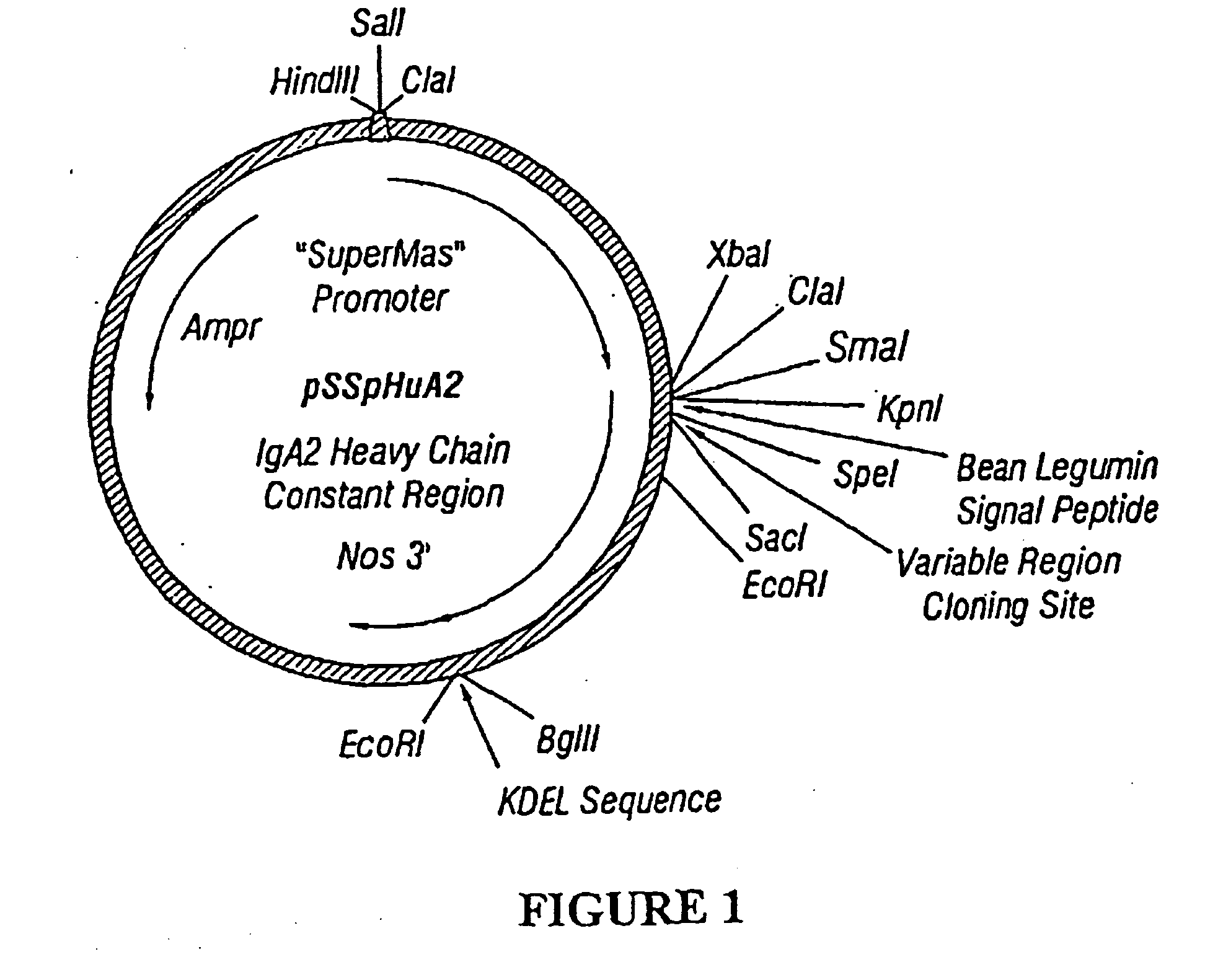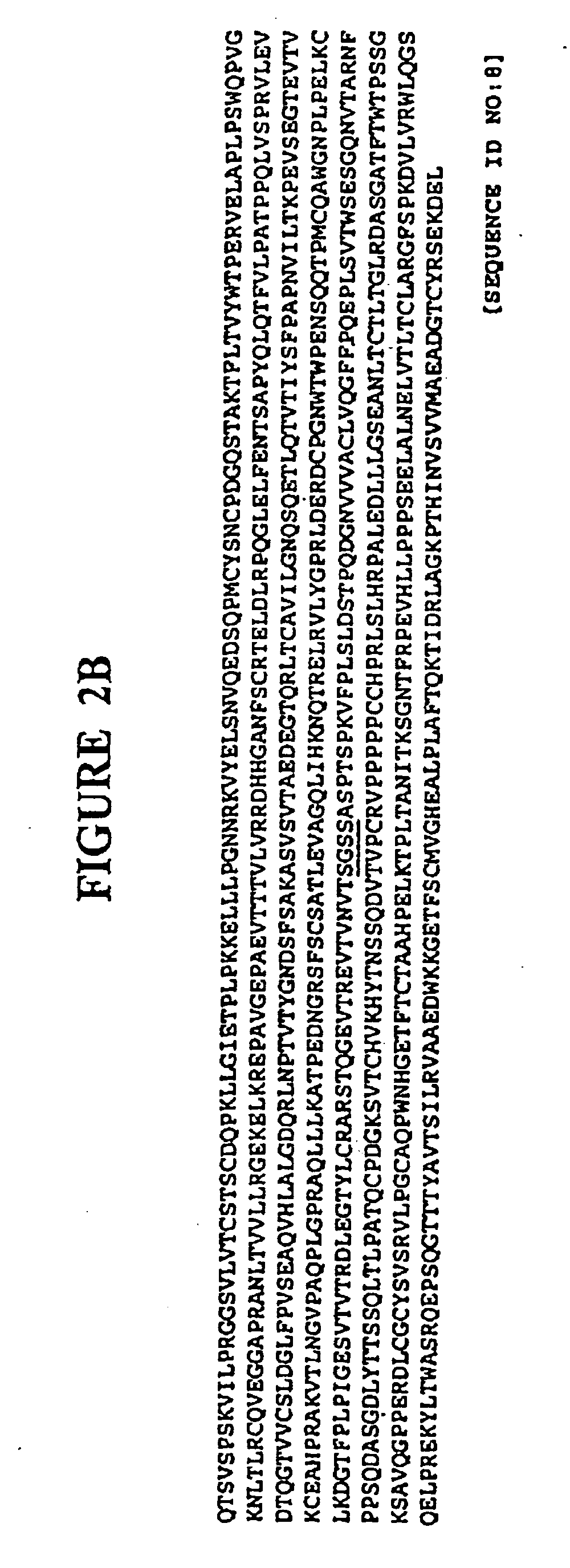Chimeric toxin receptor proteins and chimeric toxin receptor proteins for treatment and prevention of anthrax
a technology chimeric toxin, which is applied in the field of chimeric toxin receptor proteins for treatment and prevention of anthrax, can solve the problems of sinusitis and asthma exacerbation, high concentration of pa, and significant complications, and achieve the effect of improving stability
- Summary
- Abstract
- Description
- Claims
- Application Information
AI Technical Summary
Benefits of technology
Problems solved by technology
Method used
Image
Examples
example 1
Construction of ICAM-1 Immunoadhesin Expression Cassettes
[0271] A cassette encoding ICAM-1 extracellular domains D1 through D5 was prepared by PCR cloning. Specifically, a fragment containing all five extracellular Ig-like domains of ICAM-1 was amplified from plasmid pCDIC1-5D / IgA (Martin, et al. J. Virol. 67:3561-8, 1993) using the following oligonucleotide primers:
5′-TCTGTTCCCAGGAACTAGTTTGGCACAGACATC(SEQ ID NO: 6)TGTGTCCCCCTCAAAAGTC-3′5′-CATACCGGGGACTAGTCACATTCACGGTCACCT(SEQ ID NO: 7)CGCGG-3′
[0272] These two primers were designed to introduce SpeI sites at the 5′ and 3′ ends of the PCR fragment (underlined nucleotides). PCR was performed with Pfu polymerase (Stratagene) to reduce accumulation of errors. The PCR fragment was cloned into the vector PCRScript (Stratagene), and sequenced before fusing to the human IgA2 cassettes (with and without SEKDEL [SEQ ID NO:4] at the carboxy-terminus).
[0273] Constructs for the expression in plants of human J chain and secretory component, a...
example 2
Expression of Assembled ICAM-1 Immunoadhesin in Plants
[0277] A. Immunoadhesin Expression Vectors
[0278] The plasmid pSSPICAMHuA2 [SEQ ID NO:9 and FIG. 8A] is 6313 bp in length. Nucleotides 49-1165 represent the Superpromoter (Ni et al., Plant Journal 7:661-676, 1995). Nucleotides 1166-3662 comprise a sequence encoding a human ICAM-1 / human IgA2m(2) constant hybrid with linker sequences. A consensus Kozak sequence (Kozak, Cell 44(2):283-92, 1986) is included (nt 1186-1192) to enhance translation initiation, as well as the signal peptide from V. faba legumin (nt 1189-1257; Bäumlein et al., Nucleic Acids Reg. 14(6):2707-2720 (1986). The sequence of the human IgA2m(2) constant region (nt 3663-3633) has been previously published (Chintalacharuvu, et al., J. Imm. 152: 5299-5304, 1994). A sequence encoding the endoplasmic reticulum retention signal SEKDEL [SEQ ID NO:4] is appended to the end of the heavy chain (nt 3634-3654). Nucleotides 3663-3933 derive from the nopaline synthase 3′ end (...
example 3
Purification of Assembled ICAM-1 Immunoadhesin
[0292] The immunoadhesin expressed according to Example 2 was purified. Calli were grown in large amounts to facilitate the development of extraction procedures. A partial purification schedule provided a stable concentrate, available in a variety of buffer conditions, for investigation of subsequent chromatographic techniques for the further purification of the immunoadhesin (See FIG. 3). Calli were extracted in a juicer, which crushes tissue between two stainless-steel gears, while bathed in a buffer containing sodium citrate (0.6M, pH 7.4) and urea (final concentration of 2M). The juice (˜1 ml / g fresh weight) was precipitated, after coarse filtration through cheesecloth, with 0.67 volumes of saturated ammonium sulfate. A green pellet was collected after centrifugation and thoroughly extracted, in a small volume of 50 mM sodium citrate (pH 6.6), with a Dounce homogenizer. After additional centrifugation, a clear brown supernatant was ...
PUM
| Property | Measurement | Unit |
|---|---|---|
| molar ratio | aaaaa | aaaaa |
| diameter | aaaaa | aaaaa |
| diameter | aaaaa | aaaaa |
Abstract
Description
Claims
Application Information
 Login to View More
Login to View More - R&D
- Intellectual Property
- Life Sciences
- Materials
- Tech Scout
- Unparalleled Data Quality
- Higher Quality Content
- 60% Fewer Hallucinations
Browse by: Latest US Patents, China's latest patents, Technical Efficacy Thesaurus, Application Domain, Technology Topic, Popular Technical Reports.
© 2025 PatSnap. All rights reserved.Legal|Privacy policy|Modern Slavery Act Transparency Statement|Sitemap|About US| Contact US: help@patsnap.com



